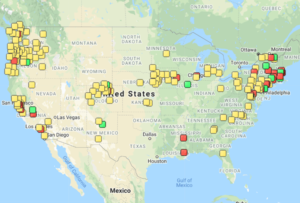As reported recently by National Public Radio on July 30, 2020, the Census Bureau announced that they have changed the end of data collection for Census 2020 from October 31 to September 30 – essentially cutting 30 days from the critical door knocking period used to reach hard-to-count communities. [1] Under condition of anonymity, Census Bureau employees involved in overseeing local census offices voiced their concerns about this action: “It’s going to be impossible to complete the count in time,” and “I’m very fearful we’re going to have a massive under-count.”
The Democratic party is understandably very concerned with the Census Bureau’s decision. Why? Because 40 percent of the American public has not completed the Census 2020[2] and most of these non-respondents or “hard-to-count” persons include Hispanics, Blacks and immigrants that have historically voted for Democratic candidates. This fact has not been lost on Republicans.
A substantial Census under-count would have serious political and economic consequences for many communities. Because the decennial census is used to determine a state’s legislative seats and Electoral College votes, an under-count could significantly change the political landscape to the advantage of the Republican party. In addition, the 2010 census counts were used for the distribution of $589.7 billion of federal tax dollars for Medicare, Medicaid, and other public services to 50 states and the District of Columbia – services that often support communities of color. Importantly, a substantial under-count in any one state could lead to the diversion of funds away from that state to other states and uses. [3] As explained more clearly by Andrew Reamer, Research Professor with the GW Institute of Public Policy:
“For the large majority of programs, money lost due to an under-count doesn’t go back to the U.S. Treasury, it is spread around all other communities. For each program, Congress determines the size of the pie, the census data determine each community’s share of the pie. For each $1 Texas loses due to an under-count, California gets an extra 14 cents, more or less. My expectation is that Texas’s decision to not have a statewide complete count effort will annually add several millions of dollars to California’s treasury, courtesy of Texas taxpayers.” [4]
Steve Dillingham, the Census Bureau director and a Trump appointee, provided lawmakers little insight about the rationale for the recent timing change during recent testimony before the House Oversight and Reform Committee. Nonetheless, House member Gomez gave Mr. Dillingham a stern warning:
“It seems like there’s an obvious pattern that you’re not in control of the Census Bureau……your name will go down in history if this is the worst census ever conducted by the United States government. You’re not going to runaway and say that this was only because of the Trump administration later on. You will be responsible.”
The change in the Census Bureau’s data collection schedule reflects the Trump administration’s growing desperation to control the outcome of the November election, and follows a series of other efforts to undermine the voting clout of groups that have typically supported the Democratic party, [5]such as attempting to include a citizenship question in the Census 2020 questionnaire, fabricating information about widespread voter fraud to discourage mail-in ballots, and delaying funding for the financially strapped U.S. Postal Service to undermine the efficient processing of mail-in ballots in the upcoming November election.
Given the high stakes consequences associated with a potential massive Census under-count, it is imperative that communities throughout the U.S. accelerate their efforts to increase response rates among hard-to-count communities. With a current non-response rate of 40 percent, it is safe to assume that the strategies that have been employed thus far have not been very effective in engaging hard-to-count communities. Therefore, following are some suggested strategies for providing hard-to-count communities an additional boost to complete the Census 2020 questionnaire over the next two months:
· The messaging must personalize the consequences to families of not completing the Census questionnaire: the loss of funds for school lunches, healthcare for mothers and children, food and nutrition programs for the poor and unemployed, immigrant support, etc. The message should also remind community members that a citizenship question is not included in the Census 2020 questionnaire. The urgency of the messaging must be elevated and impactful. Old message concepts may not suffice at this point.
· With a high penetration rate across varied demographic groups, wireless telephones should be used in communicating with hard-to-count communities and also include a link to the Census 2020 online questionnaire.
· Hispanics must receive messaging in both English and Spanish since immigrant adults are more likely to communicate in Spanish, while children and non-immigrants are more likely to communicate in English.
· Retailers whose profitability depends on the economic viability of hard-to-count communities should also do their part to encourage customers to complete the Census questionnaire through store displays and paid advertisements.
· High technology companies should allocate grants to expand the distribution of laptops and portable wi-fi devices to families during the next two months to facilitate the completion of the online Census questionnaire.
· There are numerous non-profit and community organizations that serve hard-to-count communities and maintain frequent communication with their membership, such as churches, immigrant advocacy groups, soccer teams, baseball teams, football teams, basketball teams and others. Such organizations should take advantage of the reach and trust that they have earned to promote completion of the Census 2020 questionnaire.
· Trusted and recognized business and civic leaders from local communities of color should be included in all advertisements that promote completion of the Census 2020 questionnaire.
September 30, 2020 is the new deadline to complete the Census 2020, so there is little time left for communities to mobilize their outreach efforts. A massive census under-count threatens the political and economic stability for all communities, regardless of political orientation, and needs to be taken seriously by everyone.
References
[1]Wang, H.L. (2020, July 30). Census door knocking cut a month short amid pressure to finish count. NPR, access at https://www.npr.org/2020/07/30/896656747/when-does-census-counting-end-bureau-sends-alarming-mixed-signals
[2]Census Bureau Response Rates. Accessed at https://2020census.gov/en/response-rates.html
[3]Reamer, A. (2018, March 19). Counting for dollars: The role of the decennial census in the geographic distribution of federal funds. GW Institute of Public Policy, The George Washington University. Accessed at https://gwipp.gwu.edu/counting-dollars-2020-role-decennial-census-geographic-distribution-federal-funds
[4]Reamer, A. (2020, February 26). Personal communication via email.
[5]Rincon, E.T. (2020, February 17). Undermining the 2020 Census: Trump’s Toxic Brew of Crime, Hysteria and Immigrant. Accessed at https://www.rinconassoc.com/undermining-the-2020-census-trumps-toxic-brew-of-crime-hysteria-and-immigrants



